My name is June Shores. I talk about role playing games. A lot. So I made a side blog. This is my side blog. I reblog tabletop RPG content, as well as stuff that inspires my games. Queer stuff, fantasy stuff, and Japanese stuff, mostly.
Don't wanna be here? Send us removal request.
Text
So I've been tinkering with a Sonic the Hedgehog TTRPG
My current build is an MHR retroclone. It's a lot of fun making adventures and characters for this game again!
One of my missions today was to simplify NPC creation, so that I can create opposition much faster. Most villains in the original game are as detailed as the PCs, so I wanted a way to retain their strength in the game while simplifying their construction. This way it's much easier to improvise as the GM.
So, on NPCs the solo/duo/team dice are gone and replaced with a single power level. Minor NPCs have a single power level die, like 1d8. A similar major NPC would have 2d8 or even 3d8. The stronger the NPC, the more dice they have in their power level, and the higher the step of the dice.
1d8: a minor presence, but helpful. Most minor NPCs are at this power level.
4d6: able to act in a large area, but not focused or efficacious.
2d10: able to strike with intent, and endanger one or two foes at a time.
6d12: Run. If you can.
Their power level reflects their overall power tier. The kinds of powers an NPC has are included in Fate-like aspects -- along with their other distinctive traits.
Mechanical limbs
Wielder of the Chaos Force
Sniper
Wise-Ass
And a standard short list of stunts and weaknesses makes the most time consuming part of the process go so much quicker.
Stunt: Zone Effect. You may attack multiple targets. When you do, add a d6 and keep an additional impact die for each additional target.
Stunt: Charge. For this action, step back a power level die to double an aspect, or step back an aspect to double a power level die.
Stunt: Impervious. Spend a drama die to ignore incoming [STRESS TYPE].
Stunt: Cold-Blooded. When you use a d4 aspect, add a d8 to the drama pool instead of a d6.
Stunt: Risky. Step up your impact die for this action. If your action fails, step up [STRESS TYPE].
Stunt: Keen Mind. When you create an advantage with your [ASPECT], remove the highest rolling die and double or step up your skill die.
Stunt: Speak of the Devil. Activate an opening to reroll your dice pool.
Stunt: Debilitate. When you inflict a hindrance, you may step back a power level die for the remainder of the round and step up your effect.
Drawback: Wretch. When you take action against a player, count 1s and 2s as openings. You may still use 2s in your total or impact.
Drawback: Exhausted. Add a d6 to the drama pool and deactivate [ASPECT].
Drawback: Vulnerability. Step up incoming [STRESS TYPE] to step up a drama die.
Drawback: Unreliable. Add a d6 to the drama pool and turn [ASPECT] into a hindrance.
For example:
Fiona Fox (Auto-Automaton)
Power level: 2d10
Aspects Infiltrator Unit Veneer of Sweetness Premium Robotnik Construction
Stunts
Stunt: Cold-Blooded. When you use a d4 aspect, add a d8 to the drama pool instead of a d6.
Stunt: Debilitate. When you inflict a hindrance, you may step back a power level die for the remainder of the round and step up your effect.
Drawback: Vulnerability. When attacked with water or electricity, step up incoming physical stress to step up a drama die.
Skills d8 Menace d10 Psych d8 Combat
Next time I want to talk about campaign & adventure prep, and moving away from the "event" model.
0 notes
Text
I play RPGs to surprise and delight. That's my goal. On the way to that goal, I achieve #immersion.
Not the kind where you're so deep in character that the rest of the table disappears and there is only Kirsten, Princess of Dagobah. That sort of thing is like napalm to the immersion I like.
I am instead immersed in the play itself. I am popping in and out of different stances depending on the goal in the moment. I provide feedback to other players. I reincorporate and synthesize.
This is not necessarily narrativist gameplay. I am not consciously addressing "premise" in the Forge sense. It is not necessarily even dramatist. The goal of play isn't to push the character's drama.
Rather, it's to be involved with the other players and their characters. To include them in my play proactively.
Ultimately, to take what they toss out there...
... add to it...
... change it....
... and toss it back.
However, this sort of play has a few requirements. Clarity, caring, and synchronization.
Clarity, meaning that the fiction of the game must be well understood by the table. The level of definition may vary -- some games may be an NES style mosaic. Others may be a Sargent painting. Either way, the situation must be completely comprehensible.
Caring means that we must invest our interest and empathy into each other's characters. We must have characters who we can invest those things into. If we do not care for our fellow players' characters on some level beyond the pragmatic concerns of tactics then we do not have a suitable PC group for Delightful Surprise play.
Synchronization means that we must all have accurate models of the situation and characters in our heads. This means paying attention, asking questions, and, most importantly staying in the fiction.
This does not mean staying out of mechanics. However, it does mean that certain styles of mechanics are unsuitable for this type of play. The kinds of mechanics that feedback into other mechanics, rather than the situation, are unsuitable. D&D is pretty bad about this.
That's because...
The more time we spend in mechanics, the more the different versions of the situation in our heads drift apart and cool. They are no longer warm and moving when fiddly mechanics feed into yet more fiddly mechanics.
However, mechanics are useful for magnifying the heat and life in our models when they feedback into the situation and characters.
This is why Apocalypse World works so well for Delightful Surprise play. It may have many, many rules, but they all feed back into the fiction quickly.
This also helps clarity, since as we go our models for the situation and characters are updated and clarified.
What's not good for clarity is poor conveyance. An immediately understandable, even arch situation is better than a complex subversion with lots of twists and turns in the backstory. Complexity will come naturally from the interactions.
Same for characters. We can discover complexity in play. Half the fun of Delightful Surprise is being surprised at your own contributions too.
What this adds up to is...
Well, it's flow. Flow for the whole table. A solid, tangible _rightness_ to each and every chaotic, messy, gorgeous plot twist.
I teeter, you totter.
I stumble, you catch me.
I swing wide, you anchor me like a fulcrum.
I lied. There's a fourth requirement. It's trust.
We are absorbed in the activity. It is often intimate. It is a vulnerable kind of play. I must trust you if we're going to jump.
So jump with me.
I'll catch you.
3 notes
·
View notes
Text
Reasons I'm not backing your Kickstarter #137: Don't pause your game rules to give me an ideological lecture about how the game world needs to be objective, unbiased, and unconcerned with the PCs. If it's important to the game then make rules where that naturally emerges from the GM's play.
Actionable rules > your ideological purity.
4 notes
·
View notes
Link
This looks like 500% my aesthetic.
5 notes
·
View notes
Text
Rations for various RPG Races
[[ Source. Original creator: wats6831. Additional information and images linked under each one. ]]
Universal:
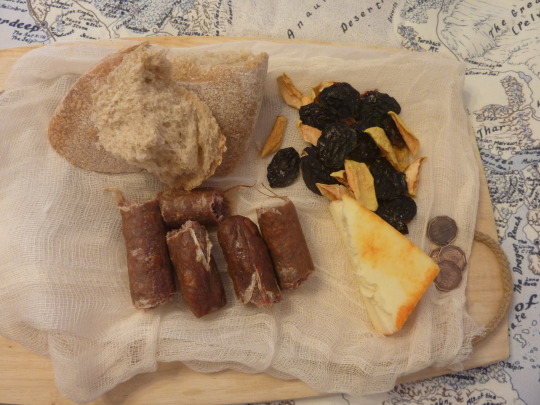
Homemade artisan herb bread, home grown and dried apples and prunes, uncured beef sausage, munster cheese. Made a small bag from cheesecloth and tied it closed.
Discussion thread here.
Dwarf:

Garlic chicken livers, smoked and peppered cheese, spiced pork sausages, hard tack, dried vegetables, dried wild mushrooms.
Discussion thread here.
Elf:

Top left to right: Evereskan Honey Comb, Elven Travel Bread (Amaretto Liquer Cake with custom swirls), Lurien Spring Cheese (goat cheese with garlic, salt, spices and shallots), Delimbyr Vale Smoked Silverfin (Salmon), Honey Spiced Lichen (Kale Chips), and Silverwood Pine Nuts.
Discussion thread here.
Halfling:
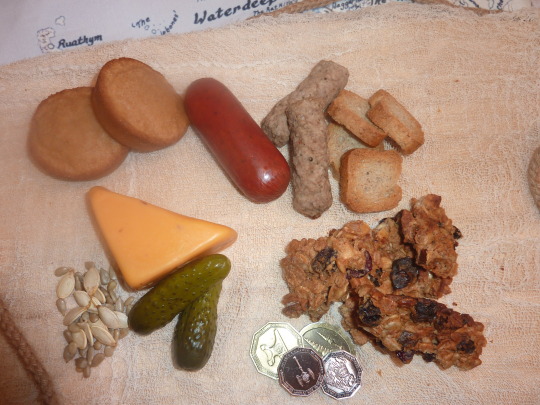
From upper left: “Honeytack” Hard tack honey cakes, beef sausage, pork sausage mini links, mini whole wheat toast, cranberry cheddar cheese mini wedge, mini pickles, pumpkin and sunflower seeds, lower right is my homemade “travel cake” muesli with raisins, golden prunes, honey, eggs and cream.
Discussion thread here.
Half-Orc:

Wrapped in cheesecloth and tied in burlap package. Forest strider drumsticks, molasses sweet wheat bread “black strap”, aged Munster, hard boiled eggs, mixed wild nuts.
Discussion thread here.
Orc:
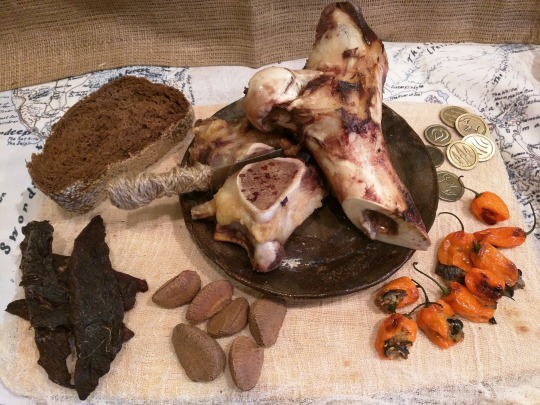
Orcs aren’t known for their great cuisine. Orcs prefer foods that are readily available (whatever can be had by raiding), and portable with little preparation, though they have a few racial delicacies. Toughs strips of lean meat, bones scavenged from recent kills, and dark coarse bread make up the bulk of common orc rations.Fire roasted rothe femur (marrow is a rare treat) [beef femur], Strips of dried meat (of unknown origin) [homemade goose jerky], foraged nuts, only edible by orcs….nut cracker tusks [brazil nuts], coarse black bread, made with whatever grains can be pillaged [black sesame bread], Pungent peppers [Habanero peppers stuffed with smoked fish and olives].
More images here. Discussion thread here.
Gnome:
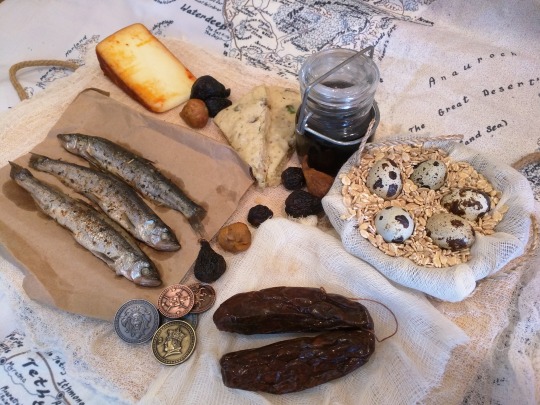
Pan fried Delimbyr smelt, spiced goat cheese (paprika crusted hand pressed Fontina), Gnome shortbread (savory pistachio), glass travel jar filled with Secomber Red (wine), hard boiled quail eggs packed in rolled oats (to keep safe), dried figs from Calimshan, and Southwood smoked goat sausage (blood sausage).
More images here. Discussion thread here.
Lizardfolk:
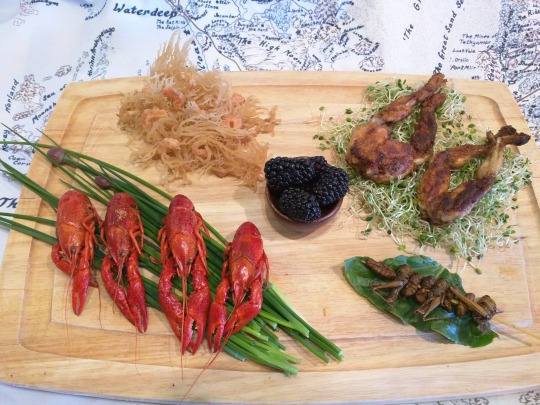
Lizardfolk are known to be omnivores, forage for a surprising variety of foods found within the confines of their marshy environs, in this case the Lizard Marsh near Daggerford. Fresh caught boiled Delimbyr Crayfish on wild chives, coastal carrageen moss entrapping estuary brine shrimp (irish moss, dried brine shrimp), Brackish-Berries (blackberries), Blackened Dart-Frog legs (frog legs) on spring sprouts (clover sprouts), roasted bog bugs on a stick!
More images here. Discussion thread here.
Drow:

From top left: Menzoberranzan black truffle rothe cheese (Black Knight Tilsit), Donigarten Moss Snails (Escargot in shallot butter sauce), Blind cave fish caviar in mushroom caps (Lumpfish caviar), faerzress infused duck egg imported from the surface Realms (Century egg), Black velvet ear fungus (Auricularia Black Fungus Mushroom).
More images here. Discussion thread here.
221K notes
·
View notes
Photo
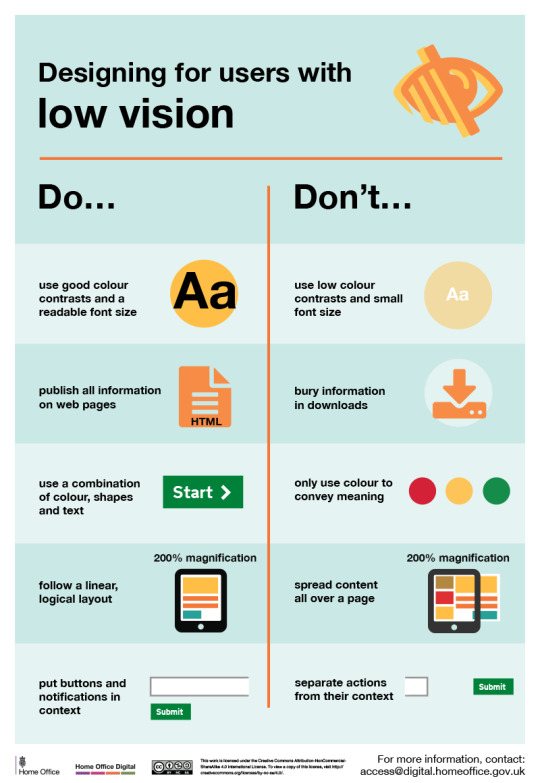
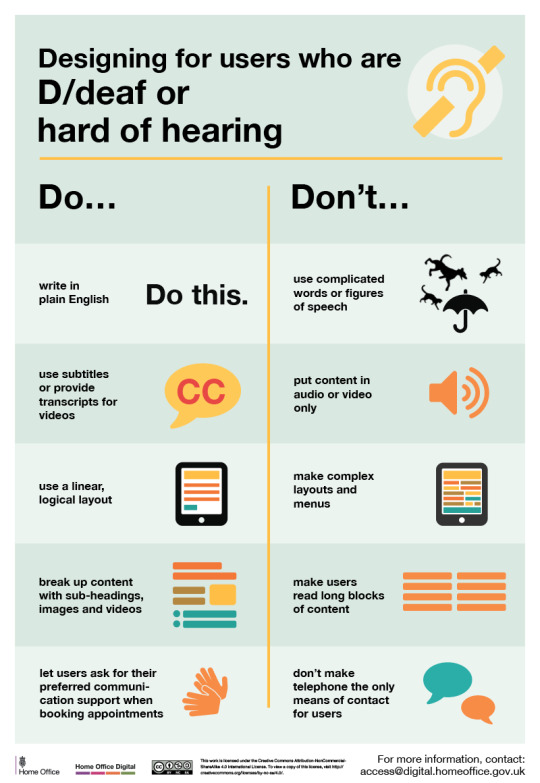
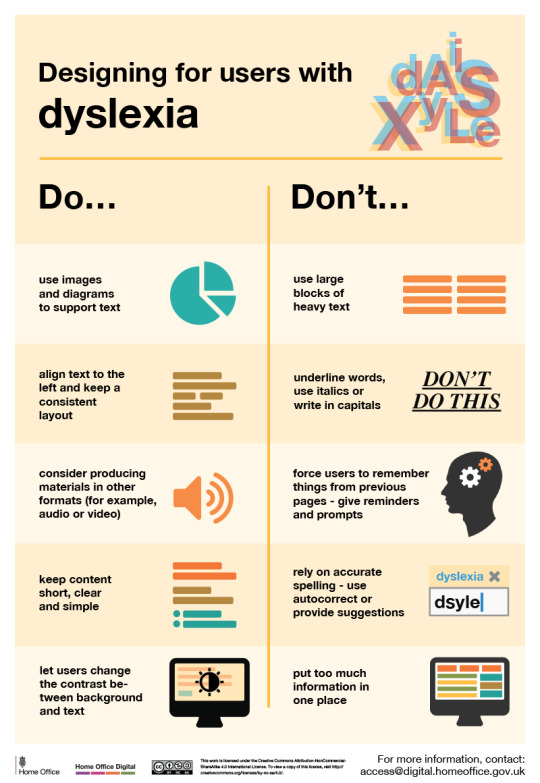


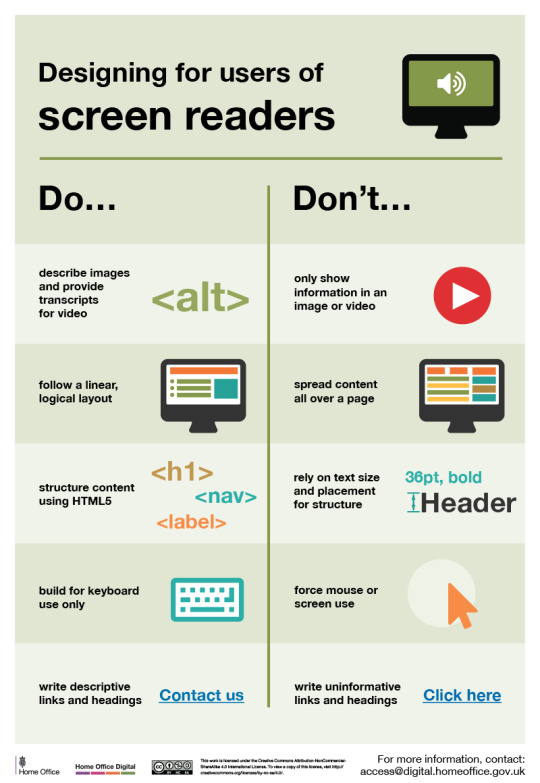
Dos and don'ts on designing for accessibility
Karwai Pun, GOV.UK:
The dos and don’ts of designing for accessibility are general guidelines, best design practices for making services accessible in government. Currently, there are six different posters in the series that cater to users from these areas: low vision, D/deaf and hard of hearing, dyslexia, motor disabilities, users on the autistic spectrum and users of screen readers.
[…] Another aim of the posters is that they’re meant to be general guidance as opposed to being overly prescriptive. Using bright contrast was advised for some (such as those with low vision) although some users on the autistic spectrum would prefer differently. Where advice seems contradictory, it’s always worth testing your designs with users to find the right balance, making compromises that best suit the users’ needs.
[github]
89K notes
·
View notes
Text
How to Create Compelling Characters for RP, a Guide
This is the first part of a series of play-by-post roleplaying guides. The series is a set of best practices that I've stumbled upon and developed into something that works, and works well. Methods and madness to make your by-post play results more reliable.
In this guide, you’ll learn how to create characters that other RPers will be compelled to play scenes with. From concept to their favorite flavor of chips, in a few steps you can create characters that pop off the page. Now, this is not going to be effortless. Like anything worth doing, it’s worth doing well. But it will make starting & playing scenes much easier later on.
The best part is, this process is portable. You can do it regardless of the structure of the RP, filling in the gaps of any roleplay's character creation process.
In many freeform play-by-post RPs, members are asked to fill out an application before they can play a character.
Character applications are gatekeepers. They do not ensure worthwhile characters. They just keep out the characters whose backgrounds do not fit the setting, or whatever else the admins don’t want in their RP. That’s good for certain kinds of settings. However, there is an unfortunate myth that they’re necessary for good characters. Most often, the character comes out of the application process with little substance, just a bunch of surface details and justification without any reason for other players to care about them, let alone to create enough interest to play a scene with them.
Here’s a better way.
Step one: Recon
Scope out the environment. Look for characters who you want to interact with. Then ask yourself, what would be a good type of character to interact with them? What would be a good relationship dynamic to play out with each of them? Looking at their relationships and what’s happening with them, how can you make their narrative more rich?
Answer these questions and come up with your own as well. Look at several different characters and answer similar questions for each one. When all this is done, ask yourself what sort of niche in these relationships you could fill and that you would be excited to play. This is the foundational step for your character.
Now that you’ve interrogated the situation, you’re equipped for the next steps.
Step two: Concept
Write up a short summary for your character. Who they are, what they do, what they look like. Make somebody who fits into the world, but still make them distinctive. This should include a broad archetype, a character defining flaw, and two admirable qualities. Keep it brief though, no more than 70 words.
“Hinata is that cool upperclassman who runs track and field. She has this meticulously crafted Good Girl image and is pretty popular, but she feels pretty pressured by her high class family to succeed. She’s graceful and empathic, but she tends to condescend. It’s not that she thinks she’s better than you, it’s that she feels like she needs to be the adult in all situations.”
Step three: Talk
This is where you get other writers to care about your character.
Bring your concept to the other members of the RP. All those situations that you came up in the recon phase come in very handy here. While you’re conveying your character, tell the other players about the different interactions that you might have with them. This doesn’t have to be long, in fact less is more.
“Hey, you know how Asahi is just this cute little sweetheart? She needs an upperclassman to dote all over her. Hinata is going to be this new, twitterpated, protective figure in her life.”
Then ask questions, like “How would they feel about this?” “What could you see happening?” “Where would you like to take this?”
Bring those possible interactions to the players of each character you scouted. When you’re done, everybody should be good and properly excited for this character. Now to stick the character creation landing.
Step four: Development
The vast majority of character applications have a particular structure. They have a space for personality, appearance, and history. They also have particular priorities, very commonly an emphasis on stamping out the dreaded Sues by justifying each and every character trait with their history.
This is useless for creating meaningful interactions or engaging narratives. What’s more, it doesn’t even create a good character. Without your own process in the background, all you end up doing is writing a bloated backstory to explain a bunch of empty surface details.
Here’s one method that I use to fill in the missing depth.
Before you fill out an application, lay out your character’s background traits in the categories below. Just a few bullet points in each category will do. Keep in mind the interactions that you’re looking forward to and first write in a few things that will enable them. Then fill the background out with other details that might suggest new situations. You don’t have to complete it in order, or even complete every single step before moving on to the application. Whenever you feel like you have a good grasp of the character, feel free to skip ahead to the application.
The first category is the character’s surface details. Appearance, likes, dislikes, things they do where they live, and so on. All the details and facts about them. There are a million and one things that belong in this category. Don’t go too big, but make sure they resemble somebody you want to play. When you write a new one on the spot in a thread, add it in here.
The second category is the character’s instincts and impulses. How do they express their vices and more base instincts? How do they express their sexuality? What makes them furious? What are they greedy for? When in doubt, give them a specific temptation in each of the cardinal sins.
The third category is all about their needs. What is it that they’re missing, or would make them a better person if they had it? What will bring them peace or real happiness?
The fourth category is their affectation and the image that they project. What sort of person do they try to be, and how?
The fifth category is their logical brain. How do they solve problems? Are they practical? Are they good at math? Engineering? Puzzles? Memorization?
The sixth category is their creative brain. How do they express themselves? Are they a confident artist, or are they incapable of drawing stick figures? Do they do poetry, music, sculpture, paper crafts? How good are they at connecting to or communicating with people?
And finally, the seventh is their history. This is the category that gives context to the others. Write it like you would any other history, with examples, causes, and effects of the traits you outlined above.
Now you have a complete and fully realized character, ready to be put into any number of situations. It’s important not to go overboard, in fact just write enough material to fill out the application. You don’t want to lock yourself into something super specific before you’ve even finished one scene. Character development is in the scenes, after all. Make sure you have the essentials to your concept down though.
Step five: Begin
Now you’re ready to write your application or profile. With all this laid out in an easy to see way, it’s a snap to go in and summarize the information in the application fields.
Usually when characters are created for RP, it’s “lonely fun.” You bring this character fully formed into the world and then retroactively fit them into it. You don’t usually say to others “Here’s what’s in it for you,” until after they’ve been created, like with shipper apps. Doing so before, however, gives you a much bigger opportunity to get involved with the community and have things to do right out of the gate. It also gives you something to start with, so that you’re not aimlessly fluffing up an application without the basics covered. Developing the character after that’s done also gives you a definite throughline for your application.
I hope this gives you a head start in creating characters. I’m not super consistent with it, but this is a process that I’ve seen an astonishing degree of success with.
1 note
·
View note
Text
"This is my OC!" and RPG Hacking Communities
These two characters are John Egbert and Rose Lalonde from the webcomic Homestuck.
They have a few common categories of traits that are easily compared. A representative color, a symbol, a hair style, and so on.
These two are Sonic the Hedgehog and Knuckles the Echidna from the Sonic the Hedgehog video games.
They also have many easily compared traits. Color, head silhouette, eye shape, super power, and so on.
Let's call these sets of traits templates.
All these characters are also rendered in simple styles that pretty much anybody can draw. (Homestuck more so than Sonic)
Follow these templates and you have your very own original character that can fit into that universe. Here are a couple of mine.
This is part of what makes the fandoms around these franchises so engaging when you're in them. It's easy to participate in the fandom, to create stuff that celebrates your fandom for these things. The barrier to being a creator is very low, and actually creating is a lot of fun.
Now, what does this have to do with RPGs? Well, let's take a look at a standard PbtA move. This one is from Urban Shadows.
Escape
When you take advantage of an opening to escape a situation, roll with Blood. On a hit, you get away. On a 10+, choose 1. On a 7-9, choose 2:
You suffer harm during your escape
You end up in another dangerous situation
You leave something important behind
You owe someone a Debt for your escape
You give in to your base nature and mark corruption
You have a situational trigger, a prompt to roll and add a stat, a list of outcomes and choices for a 10+, 7-9, and an implied 6 or less results in a hard move. Each of these outcomes feeds back into the situation.
Follow that template and you have your very own original RPG mechanic. Here's one of mine, from my Dungeon World character class The Princess.
Well Met, Hailfellow
When you meet hostile intent from people who are basically good with optimistic friendliness roll +CHA. On a 10+ carry one forward to become friends. On a 7-9 they are listening, but you will need to act fast.
This goes similarly for Fate and Cortex Plus too. They both have similarly consistent structures in their games, which can be mucked around with for plenty of variation. And the way they're presented, it's really easy to make new content for them. The result is that all three of these game families have very active online fandoms — each with thriving hacker communities constantly generating new content. Even for "dead" games like Marvel Heroic Roleplaying, they still enjoy new content on a regular basis because the fan-creation community is so damn dedicated.
And just look at stuff like Pokemon (I could go on for a while about all the different levels that Pokemon engages its audience), Pretty Cure, Ben 10, and even Tumblr art memes like "witchsonas".
I've seen a lot of talk recently, especially on the Story Games forums, about how to make a breakout hit in RPGs, and I think this would be a big part of it. Making fan-creation fun on every single level, from color to tinkering with mechanical nuts and bolts, would go a long way toward hooking an audience in the long term.
0 notes
Text
A thing for an RPG. Probably a simple Apocalypse Word game involving food derived magic and little fantasy adventures. Definitely inspired by Harpy Gee and Harvest Moon
The Item Shop Owner
You own a shop in town. Name two things you sell and write them in. Maybe groceries, antiques, tools, construction materials, pet supplies, furniture, toys & games, or stories. Once a week, when your shop has been open roll + Steady. On a 10+ choose 2. On a 7-9 choose one.
You made some extra gold, take +1 forward to your next Shopping roll.
Your store is not dusty or unkempt.
You do not have to restock after losing items.
On a 6 or less, the GM chooses 1.
You get a special order. The GM will tell you what it is and how to get it.
You are overworked, take the Exhausted condition.
Choose 1 background
Witch
Perhaps you come from a family of witches, or you’re self-taught, or maybe you even went to school for it. You get a flying vehicle (capacity 2, reliable) which can get you across town reasonably quickly. You also get a small animal as a magical assistant. You can talk to them and command them.
Native
You’ve lived in town all your life. When you reach out for a favor, roll + Warm. On a 10+ they’ll do it, no questions asked. On a 7-9 they’ll ask for a favor in return. On a 6 or less, they’re only interested in collecting a debt from you. Tell the GM if it’s a favor, a coin, or a borrowed item.
Stats
You have +1 Steady, +1 Warm, -1 Bold, 0 Magic. Add +1 to any stat.
Advances
When you mark 5 XP, erase all your XP and check off an option below.
You are gifted a magical item.
Witch: your familiar goes through a metamorphosis. They gain a special ability (Maybe elemental breath, flight, or size shifting?) Native: when you ask for a favor, you also carry +1 forward to completing their favor.
Gain +1 Steady. You’ve hired somebody new.
Gain +1 Warm. Children or animals follow you around.
Gain +1 Bold. You catch a shoplifter in the act.
Gain +1 Magic. You discover a hidden map in your shop.
Take a side job. When you work your side job carry +1 forward to your next Shopping roll.
4 notes
·
View notes
Photo
This has me wanting to play a Dungeon World game in a modern-ish setting, but with fantasy trappings. Would be so dope.

coolest girl and her biggest fan
6K notes
·
View notes
Photo
AHHH! I have literally been waiting years for this game, Ewen! So exciting!

The artwork (by bybystarlight!) for Raspberry Heaven is done, so the game is just about ready to launch! RH is a game for heartwarming slice of life stories in the vein of 4-koma manga like Azumanga Daioh and Hidamari Sketch, and it comes as a set of 6"x6" cards. It’s a game I’ve been trying to figure out how to make for about 8 years, and I can’t tell you how exciting it is to be on the cusp of finally getting it out.
9 notes
·
View notes
Text
Something that I might implement for a shoujo Fate game…
Something that I might implement for a shoujo Fate game…
No skills. No approaches. Have something that you want to reliably do? Take a stunt. Also, no consequences.
Every player character has a set of stressor aspects, each which gives them a set of conditions (Fate Toolkit: http://fate-srd.com/fate-system-toolkit/conditions). The actual numbers don’t matter right now.
Stressors can represent physical weakness, thus opening you up to physical harm,…
View On WordPress
0 notes
Text
Important Issue on Creating Characters
I’ve seen something a bit…unsettling among some writers who talk about characters they’re developing and I think it’s important to address this.
We all want to create cool, memorable characters who are interesting. We all know that to do this, our characters need to have personalities, good traits, bad traits, changes throughout the story, and so on.
However, I’ve seen too many writers talk about certain things that they believe make their characters cooler, more interesting, more original, or more well rounded.
So, to be blunt:
Making your character anything other than straight does not automatically make your character well rounded, dynamic, cool, interesting, or original.
Making your character anything other than cis does not automatically make your character well rounded, dynamic, cool, interesting, or original.
Making your character anything other than white does not automatically make your character well rounded, dynamic, cool, interesting, or original.
Making your character anything other than thin does not automatically make your character well rounded, dynamic, cool, interesting, or original.
Giving your character a mental illness, a disability, a neurological disorder, etc. does not automatically make your character well rounded, dynamic, cool, interesting, or original.
Please stop treating these factors as personality traits. They may influence a person’s personality, behaviors, thoughts, actions, and relationships, but they are not traits themselves.
12K notes
·
View notes
Photo

I’m usually not one for sharing “before and after” pictures.
4K notes
·
View notes
Photo


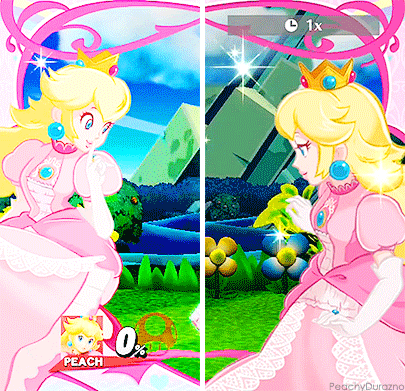
Super Smash Bros. for Wii U/ 3DS
Princess Peach´s illustrations on the border of the screen for her final smash!
*Each and every one of the illustrations appear randomly, they can appear on the left or on the right. And yes, the same illustration can appear on both sides*
requested by: anime-an-cats
19K notes
·
View notes

